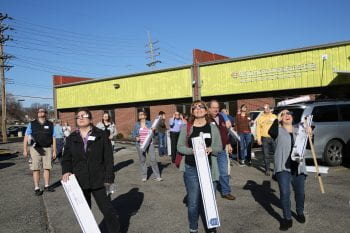With great care, Paul Markovits unravels a child-sized t-shirt and dangles it before a packed room of teachers.
It reads “ECLIPSE ’79,” and was worn by his 4-year-old daughter when Markovits’ young family witnessed the last total solar eclipse visible in the continental United States. That was nearly 40 years ago on February 26, 1979, and the family lived in Bozeman, Montana, a site on the path of the eclipse.
The teachers offer Markovits a chorus of ‘Awws.’ They are here at the Institute for School Partnership at Washington University on a Saturday morning in January to learn more about the upcoming solar eclipse, which will occur August 21, 2017. During the eclipse the moon will completely blot out the sun. The only thing visible is the sun’s faint atmosphere, which looks like a beautiful halo.
The awe in which Markovits describes his last encounter is palpable.
“It was fantastic,” says Markovits, an ISP science educator. “The sun disappeared, the temperature dipped, birds started chirping and dogs barked like crazy.”
He never thought he’d get another opportunity to witness a total solar eclipse. But in mere months he’ll see another one, literally, from his backyard. While Southern Illinois will experience the longest duration of totality (more than 2 minutes and 40 seconds) – Missouri will experience as much as three hours of the partial eclipse and 2 minutes and 30 seconds of totality.
Markovits, in partnership with members of the St. Louis Astronomical Society, is educating teachers in the St. Louis area about the eclipse and how to safely observe it. For instance, Markovits advised teachers on modeling an eclipse and ideas for safe viewing. It’s imperative that observers protect their eyes before the eclipse becomes total. They can wear solar glasses during this time. The few minutes of total eclipse, when the sun is completely covered, are safe.
Liz Oliver, a seventh-grade science teacher at Hixon Middle School in the Webster Groves School District, is overjoyed with the workshop.
“They’ve given us great images and models to talk to the kids about,” she says. “Knowing this information has been vetted is extremely helpful.”
She’s excited to share all she has learned, not just with her students, but with other teachers.
Fellow Hixon science teacher Dawn Meyer says she loves that they’re “learning how to speak the language.”
“I like that I understand a bit more about what is going on and can speak more knowledgeably and answer questions,” Meyer says.
The teachers left the workshop with materials, a pinhole viewfinder and glasses for their students. Richard Hermann, outreach program coordinator in Washington University’s Department of Earth and Planetary Sciences in Arts & Sciences; and Jim Small, president of the St. Louis Astronomical Society, also were on hand to advise teachers.
The free total solar eclipse workshop for K-12 teachers has been one of the most successful to date. Sessions have quickly filled up and led to wait lists. The next workshop set for April 8, 2017, is fully booked. Additional workshops are being added. Check our website for updates.
January 2017 | by, Myra Lopez

